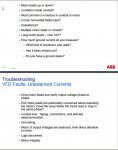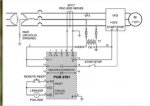malachi constant
Senior Member
- Location
- Minneapolis
Hi all,
I've been asked to look at a VFD ground fault issue that has plagued a client for over a year. Any thoughts you have are appreciated...
* Suburban school district. Possibly three buildings affected, all within two miles of each other.
* The mechanical systems at each of these schools were recently replaced (some in summer 2013, some in summer 2014). Still gathering info on the electrical services but at this point I believe they are 480V, were not upgraded, and I read a note that says they do not have surge suppression on them. Trying to confirm all that.
* There were no known issues prior to the mechanical upgrade, but now have experienced recurring issues on the VFDs and with motor burnouts.
The issues are:
* VFDs on multiple fans and pumps are tripping on ground faults. In some locations wire nuts have melted. At least one motor (toilet exhaust fan) has burned out.
* Electrician did a very thorough review of the situation in June and found two instances of wire nuts melting (at same motor, on different phases). Electrician stated this is typically caused by loose terminations but both nuts were solidly connected. Speculated that there was a short circuit or overvoltage. Did not find any evidence of faulty wiring.
* Electrician also found VFDs were programmed to 1.56% over FLA instead of manufacturer recommended 1.15%. Electrician reprogrammed a few of the VFDs and recommended someone come out and verify all were programmed correctly. When the electrician returned in August they noted the VFDs had reverted to their original settings.
* I have a fault log showing trips on VFDs at one school (the school with the most issues) over the summer. They appear to be very intermittent and not concurrent with each other. Each one notes that the voltage at the time of trip is between 600-700V on 480V units.
* The utility was engaged with little action to date. They did tell the Owner they were going to switch their cap bank during a given hour one morning, and the Owner confirmed three trips that hour, but only at one building (the one with the most issues). I am told the utility has stated that any problems resulting from the cap bank switching are the Owner's problem to resolve.
* The utility had applied data logging devices to each school, I do not believe we have seen copies of these but am trying to obtain.
* I do not believe to date that the VFDs have been properly reprogrammed/commissioned, even though this request has been repeatedly made since June.
So...
* Three buildings in close proximity.
* Frequent VFD ground vaults at all of them, no observed pattern.
* Possibly related to cap bank switching.
* Possibly related to improperly programmed VFDs. (Why would the handful that were reprogrammed later revert to old settings?)
* Possibly no surge suppression present. (If so seems like a pretty easy decision to add it.)
As you can see I'm still diving into it but any thoughts you all have on the matter is appreciated. Also curious how likely it is that there is widespread damage to the motors or drives. I'll keep you updated as everyone loves a good mystery... Thank you!!
I've been asked to look at a VFD ground fault issue that has plagued a client for over a year. Any thoughts you have are appreciated...
* Suburban school district. Possibly three buildings affected, all within two miles of each other.
* The mechanical systems at each of these schools were recently replaced (some in summer 2013, some in summer 2014). Still gathering info on the electrical services but at this point I believe they are 480V, were not upgraded, and I read a note that says they do not have surge suppression on them. Trying to confirm all that.
* There were no known issues prior to the mechanical upgrade, but now have experienced recurring issues on the VFDs and with motor burnouts.
The issues are:
* VFDs on multiple fans and pumps are tripping on ground faults. In some locations wire nuts have melted. At least one motor (toilet exhaust fan) has burned out.
* Electrician did a very thorough review of the situation in June and found two instances of wire nuts melting (at same motor, on different phases). Electrician stated this is typically caused by loose terminations but both nuts were solidly connected. Speculated that there was a short circuit or overvoltage. Did not find any evidence of faulty wiring.
* Electrician also found VFDs were programmed to 1.56% over FLA instead of manufacturer recommended 1.15%. Electrician reprogrammed a few of the VFDs and recommended someone come out and verify all were programmed correctly. When the electrician returned in August they noted the VFDs had reverted to their original settings.
* I have a fault log showing trips on VFDs at one school (the school with the most issues) over the summer. They appear to be very intermittent and not concurrent with each other. Each one notes that the voltage at the time of trip is between 600-700V on 480V units.
* The utility was engaged with little action to date. They did tell the Owner they were going to switch their cap bank during a given hour one morning, and the Owner confirmed three trips that hour, but only at one building (the one with the most issues). I am told the utility has stated that any problems resulting from the cap bank switching are the Owner's problem to resolve.
* The utility had applied data logging devices to each school, I do not believe we have seen copies of these but am trying to obtain.
* I do not believe to date that the VFDs have been properly reprogrammed/commissioned, even though this request has been repeatedly made since June.
So...
* Three buildings in close proximity.
* Frequent VFD ground vaults at all of them, no observed pattern.
* Possibly related to cap bank switching.
* Possibly related to improperly programmed VFDs. (Why would the handful that were reprogrammed later revert to old settings?)
* Possibly no surge suppression present. (If so seems like a pretty easy decision to add it.)
As you can see I'm still diving into it but any thoughts you all have on the matter is appreciated. Also curious how likely it is that there is widespread damage to the motors or drives. I'll keep you updated as everyone loves a good mystery... Thank you!!


